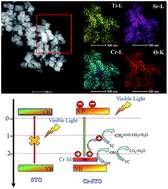The removal of tetracyclines (TC), the extensively used antibiotics, from the environment has become an important issue. Recently, photocatalytic oxidation on the surface of semiconductors has been found to provide a good tool for the degradation of TC; however, most of these reactions are UV-light driven rather than visible-light driven. Here, Cr doping of SrTiO3 results in a large decrease in the band gap energy, making Cr3+ doped SrTiO3 (Cr-STO) an attractive material for use as a visible-light-driven photocatalyst for tetracycline (TC) degradation. The photoactivity is improved when the Cr/Sr weight ratio changes from 0.5% to 2%, and decreases when the Cr/Sr weight ratio changes from 3% to 10%. In this paper, we also explain the relationship between the doping and the photocatalytic activity. The existence of ˙OH radicals and holes was studied by the electron spin resonance (ESR) spin-trap technique and trapping experiments.

